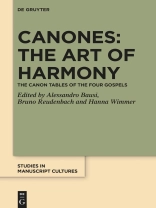The so-called ‘Canon Tables’ of the Christian Gospels are an absolutely remarkable feature of the early, late antique, and medieval Christian manuscript cultures of East and West, the invention of which is commonly attributed to Eusebius and dated to first decades of the fourth century AD. Intended to host a technical device for structuring, organizing, and navigating the Four Gospels united in a single codex – and, in doing so, building upon and bringing to completion previous endeavours – the Canon Tables were apparently from the beginning a highly complex combination of text, numbers and images, that became an integral and fixed part of all the manuscripts containing the Four Gospels as Sacred Scripture of the Christians and can be seen as exemplary for the formation, development and spreading of a specific Christian manuscript culture across East and West AD 300 and 800.
In the footsteps of Carl Nordenfalk’s masterly publication of 1938 and few following contributions, this book offers an updated overview on the topic of ‘Canon Tables’ in a comparative perspective and with a precise look at their context of origin, their visual appearance, their meaning, function and their usage in different times, domains, and cultures.
Tentang Penulis
Alessandro Bausi, Bruno Reudenbarch and
Hanna Wimmer, University of Hamburg, Germany.












